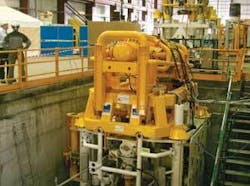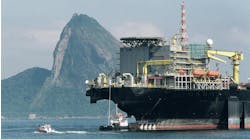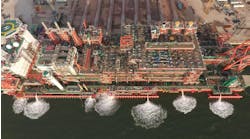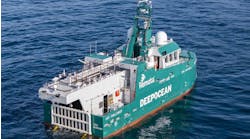Tom Bryce - DES Operations
MARS (Multiple Application Re-injection System) began as a low-risk method for subsea retrofit of a multiphase pump. It is being adopted as a standard interface by several operators on new and existing wells, both subsea and topside, offering multiple field development opportunities throughout the life of field. The technology currently is being used in the GoM, UK, West Africa, and in Norway on a number of applications ranging from pumping, sampling, metering, and well stimulation.
Production optimization
MARS is a new production optimization technology that establishes the wellhead as the unit of production, enabling systems to be mounted directly onto christmas trees. The principle behind MARS is simple: by introducing a coaxial flowpath insert into the christmas tree (either the main bore or the choke body); well fluids are directed externally to a flow loop on the Universal Work Platform (UWP), which houses the processing hardware. The flow then is returned to the wellhead and back into the existing flowline infrastructure. This means the installation has been classed as tree intervention by the UK’s Health and Safety Executive, rather than full well intervention and, therefore, does not involve the same demanding planning procedures, costs, or risks. Processing hardware is installed between the existing isolation barriers to eliminate the need for expensive, high risk well intervention, field shut-down, or flowline decommissioning, and also minimizes production losses. The processing hardware options include multiphase pumping, multiphase metering, fluid sampling, sand management, separation, bulk water management and re-injection, raw seawater injection, pressure boosting, dehydration, chemical injection, and hipps systems.
Subsea/drytree
In subsea applications, the “MARS via the choke” method is used and is installed using standard subsea choke retrieval tools and procedures with a work class ROV. Because the system is outside the well isolation envelope, well integrity is maintained throughout the installation operation using the tree’s existing barriers. This system enables any processing equipment to be mounted directly on the christmas tree via one of several variants of the patented co-axial connection.
The MARS universal interface can be retrofitted to any wellhead at any time; installed on new wellheads; or, prepared for future installation for full intervention capability. In addition to providing access to the subsurface flow architecture, this system provides a way to intervene in the flowline for hydrate management and chemical treatments.
This product initially was developed and applied to the extreme applications and environments, i.e. deepwater subsea. Despite being hyperbarically qualified to 3,000 m, operators now look to use the same technology topside on dry wells. On platform wellheads, the “MARS via the treecap” method is used. This principle is similar to the subsea variant, but the co-axial flowpath is in the tree bore as opposed to the retrievable choke body.
The strategic drivers on platforms are not dissimilar to subsea, i.e. low risk, low cost “plug and play” reservoir optimization and metering, which can be installed without hot-work permits and shut-down requirements. As more operators tie-back new subsea step-outs to existing platforms, topside test separator facilities are being converted to meet production requirements. Therefore, the need to optimize production by quickly and safely installing multiphase flow meters and sand trapping facilities on individual wellheads becomes paramount.
Technology development
The MARS technology was developed by DES Operations of Aberdeen. The company, formed in 1999, achieved early support from UK DTI and the operating community, including BP and Shell. “They assisted us with the MARS development and test programs, and were also the early adopters of the technology,” says Brian Nutley, director of BD with DES. “In addition to addressing specific known production optimization issues, operators are increasingly looking at MARS as a ‘catch all’ field development strategy. They do not know exactly how a well or field will perform, but with MARS they are positioned to react to multiple scenarios and therefore realize the maximum value from their assets.”
DES works with both tree and choke manufacturers to ensure the equipment interface issues on new equipment are minimized for maximum upside capability. The MARS Friendly X-mas Tree (MFXT) allows operators to keep all options open, minimizing capex and delaying opex spend, while providing future flexibility to increase production and ultimate recovery. The MFXT was adopted as a standard frame agreement specification for Shell UK, BP West of Shetland, and Venture Production. DES expects this system to set a standard for all tree manufacturers.
Applications
To date, MARS technology has been applied in the following projects: BP in the Gulf of Mexico has selected MARS to tie-in two subsea multiphase pumps on the King field, and Shell [see box] in the UK has selected three MARS systems for well intervention (chemical squeeze) operations on the the Bittern field in 2007. Meanwhile, MARS Meterhead (an integrated MARS & Multiphase Metering package), will be tested on two wells in 2007. The Dry Meterhead is being used on a Norwegian platform, and Wet Meterhead is being used on a deepwater field offshore Angola.
Focused processing
“Subsea processing is no longer a future technology; it is being deployed now. Without it, current assets will remain undeveloped. It is no longer a case of if or even when, but how best to unlock maximum recovery,” says Nutley.
The associated processing technologies are maturing with Framo, Roxar, Aker Kvaerner, Cameron, and FMC all working on subsea processing product portfolios. Subsea multiphase pumping, re-injection, multiphase metering, and well stimulation operations are proven technologies and are being adopted globally by both majors and smaller independents. Additional processing technologies, including separation, dehydration, and sand and water management, are under various stages of development.
DES and MARS are part of a trend away from centrally planned processing. Not all wells in a single field are the same, so centrally planned applications technology on manifold system cannot leverage the best production and ultimate recovery from each well or maximize project NPV. MARS enables focused processing at each wellhead.
“In the past, operators typically have viewed subsea hardware expenditure, including their trees, as ‘sunk costs.’ However, with MARS and MFXT, this attitude is changing and we see development strategies emerging that established the tree as the core of the life-of-field development strategy,” adds Nutley.
Shell Bittern well intervention
In 2007, Shell will use MARS technology on Bittern field to complete subsea well stimulation operations (scale squeeze) from an ROV support vessel. Previously, this operation required a separate subsea manifold skid, which was installed manually using divers for hook-up, and, therefore, resulted in a limited window for installation. Shell estimates that MARS will not only eliminate hazardous diver-intensive operations, but also will reduce future well stimulation costs by approximately 60% per operation.
In the well stimulation operation process, the installed base of a subsea tree is first upgraded with MARS-enabled choke inserts, which effectively provides a low risk access point back into its well. Each subsequent squeeze operation uses a Universal Work Platform (UWP) mounted quick-disconnect hose assembly which is guided and locked onto the upgraded tree using an ROV.
The advantage is the ability to undertake a full squeeze campaign on multiple wells simultaneously by maximizing the vessel utilization during the chemical holding times. All operations can be completed from a low-cost RSV as opposed to the more expensive DSV. It is estimated that the frequency of these operations will increase because of the reduced risk and cost associated with this new method. Shell has purchased three separate MARS systems, two of which will be installed subsea with the third installed on the new tree prior to deployment. Once upgraded, the existing christmas tree stock can accept any number of production optimization solutions.






